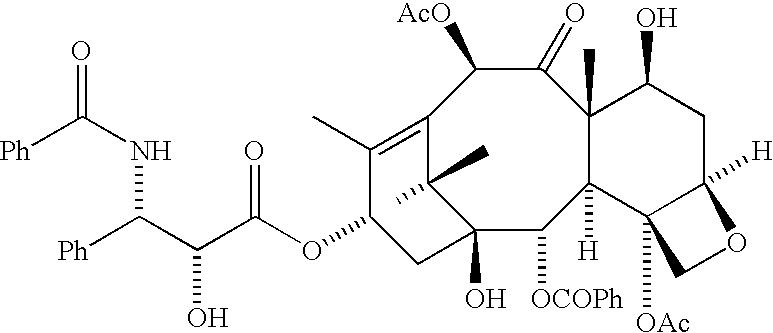Convergent Process for the Synthesis of Taxane Derivatives
a technology of derivatives and synthesis processes, applied in the field of process for the preparation of taxane derivatives, can solve the problems of difficult esterification or coupling of these two units, and the difficulty of synthesis of docetaxel
- Summary
- Abstract
- Description
- Claims
- Application Information
AI Technical Summary
Benefits of technology
Problems solved by technology
Method used
Image
Examples
example 1
Oxidation of Vinylic Compound
[0088]
Oxidation of Compound (16) to Compound of Formula (8b):
[0089]In a round bottom flask, NMO (10.49 g, 75.2 mmol) was stirred with ACN (200 mL) to obtain a solution. With stirring, to the solution was added 10% aqueous NaIO4 (165 mL, 76.4 mmol), additional ACN (50 mL) and deionized water (50 mL). TPAP (504 mg, 1.4 mmol) was added after which a solution 16 (15.0 g, 38.3 mmol, 0.5 g / mL ACN) was added over the course of approximately 1 minute under ambient conditions. After ˜50 minutes additional ACN (50 mL), NMO (10.0 g, 71.7 mmol) and 10% aqueous NaIO4 (82 mL, 38.0 mmol) were added to the reaction mixture to drive to completion. After reaction was completed, to the stirring reaction mixture was added. IPAc (300 mL) and water (200 mL). The mixture was vacuum filtered to remove precipitated reagents, and then it was partitioned. The aqueous phase was twice back extracted, once with IPAc and then with 2:1 n-heptane / IPAc. After each extraction the organic ...
example 2
Pivaloyl Mixed Anhydride
[0091]
[0092]The sodium salt of the acid of formula (8a) may be obtained by the method of Bombardelli of al, WO 01 / 02407 or by neutralisation of the compound of Example 1.
[0093]A solution containing 55.00 g (127.5 mmol) of side chain, said sodium salt, in dichloromethane (550 mL) was washed with cold (0-5° C.) 2N aqueous HCl solution (2×460 mL). The organic phase was washed with 12.5 wt % sodium chloride solution (2×460 mL), dried over anhydrous sodium sulfate, filtered and concentrated in vacuo to constant weight to afford 50.35 g (96.5%) free acid, compound (8a).
[0094]To a 0-5° C. solution of 5.51 g (13.5 mmol) free acid compound (8a) in anhydrous THF (50 mL) under an inert atmosphere of nitrogen was added 1.78 mL (16.2 mmol) 99% 4-methylmorpholine and 1.99 mL (16.2 mmol) 99% trimethylacetyl chloride. The progress of the reaction was monitored by HPLC (a reaction aliquot was quenched into MeOH). After one hour, 0.20 mL (1.8 mmol, 0.2 eq) 99% 4-methylmorpholi...
example 3
Pivaloyl Mixed Anhydride and Use
[0095]The mixed anhydride of formula (8c) is prepared and employed in situ as follows
[0096]A 10 mL round bottom flask with two necks was heated to eliminate water, then allowed to cool under N2 atmosphere. To the flask was added compound 7 (125 mg, 0.2 mmol) (as shown in FIG. 1), THF (1.25 mL), 4-methylmorpholine (40 μL, 0.36 mmol), DMAP (10.9 mg, 0.009 mmol), compound of formula (iii) (110 mg, 0.254 mmol) and finally trimethylacetyl chloride (40 μL, 0.319 mmol). The reaction mixture was stirred at 40° C. under N2. After about 2 hours, additional 4-methylmorpholine (11 μL, 0.01 mmol), 8b sodium salt (41 mg, 0.1 mmol) and trimethylacetyl chloride (13 μL, 0.1 mmol) were added to assist formation of the anhydride intermediate which then coupled to 7. After about 2 additional hours, 4-methylmorpholine (11 μL, 0.010 mmol), trimethylacetyl chloride (13 μL, 0.104 mmol) and 8b sodium salt (42 mg, 0.1 mmol) were added. After 1.5 hours more, the reaction was pl...
PUM
| Property | Measurement | Unit |
|---|---|---|
| temperature | aaaaa | aaaaa |
| temperature | aaaaa | aaaaa |
| temperature | aaaaa | aaaaa |
Abstract
Description
Claims
Application Information
 Login to View More
Login to View More - R&D
- Intellectual Property
- Life Sciences
- Materials
- Tech Scout
- Unparalleled Data Quality
- Higher Quality Content
- 60% Fewer Hallucinations
Browse by: Latest US Patents, China's latest patents, Technical Efficacy Thesaurus, Application Domain, Technology Topic, Popular Technical Reports.
© 2025 PatSnap. All rights reserved.Legal|Privacy policy|Modern Slavery Act Transparency Statement|Sitemap|About US| Contact US: help@patsnap.com



